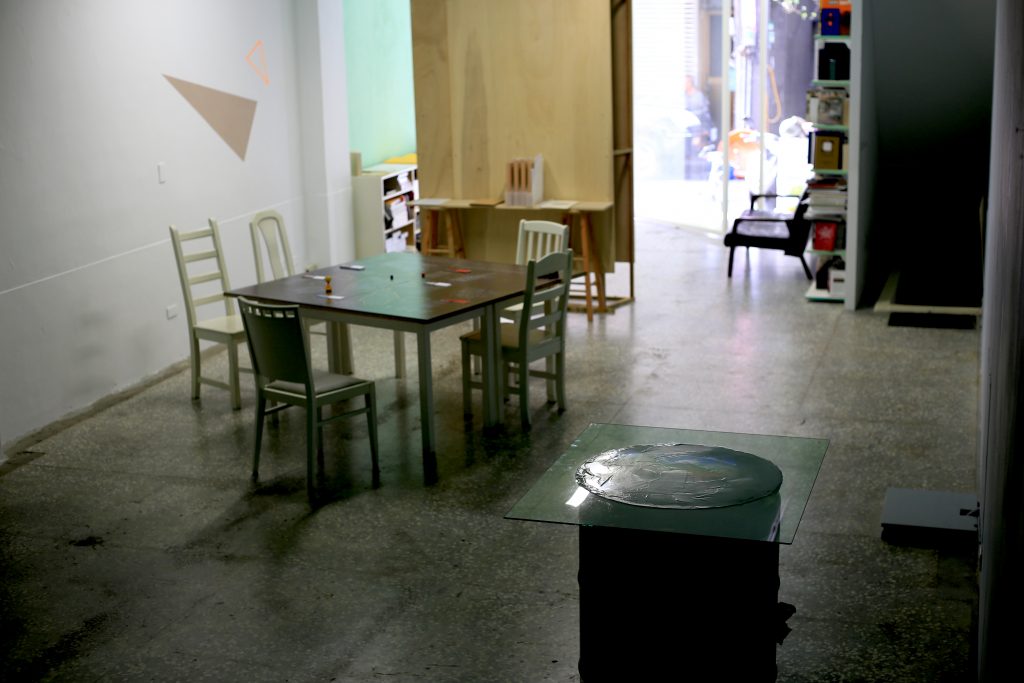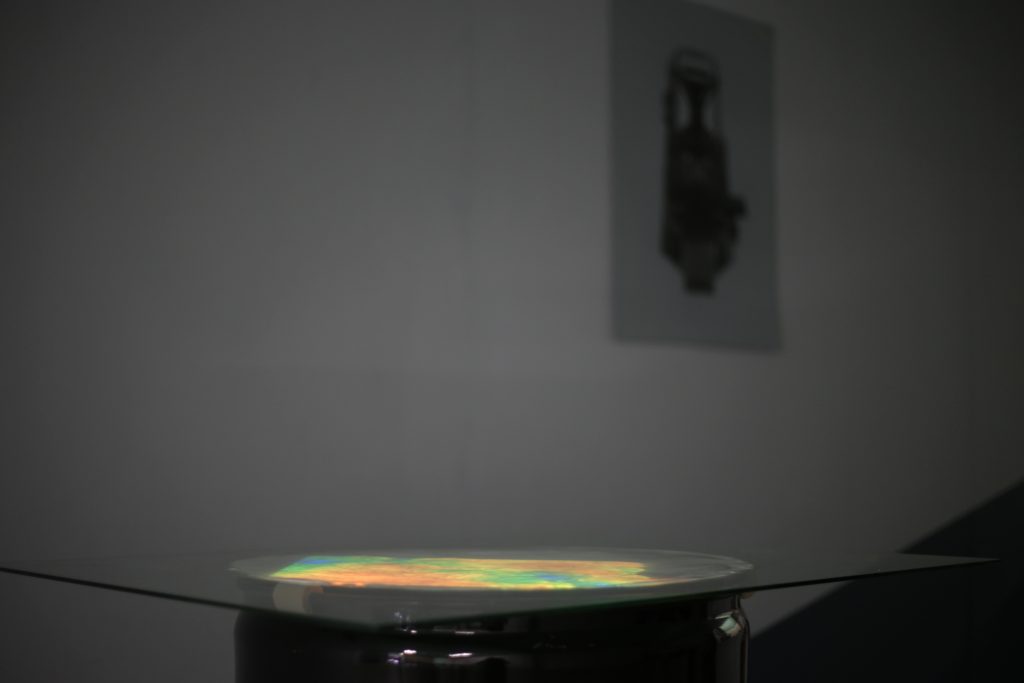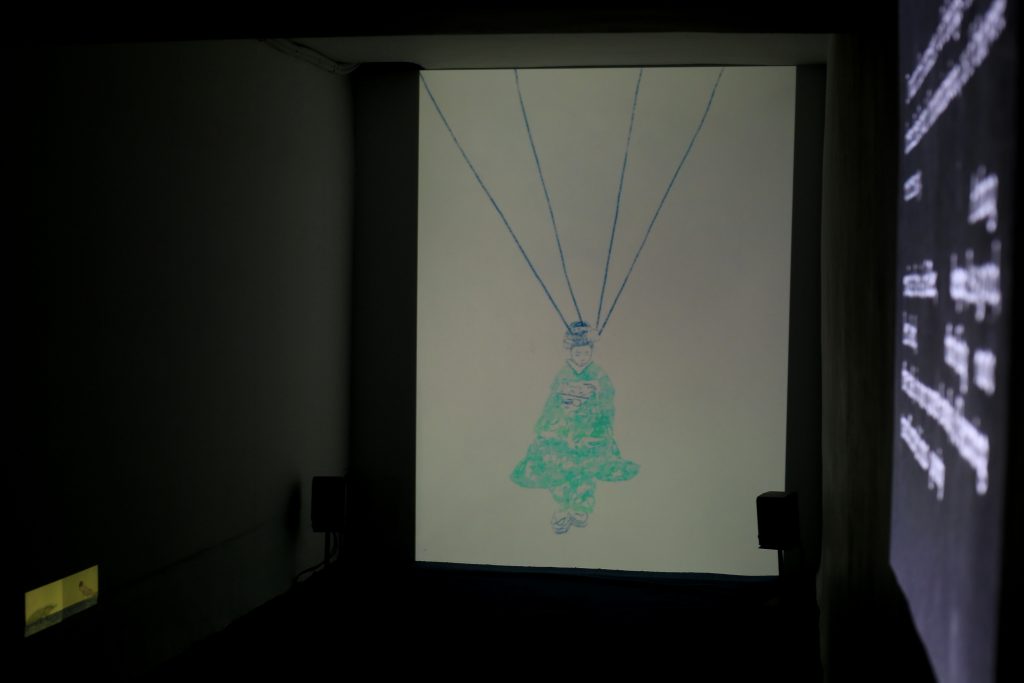 For English, please scroll down.
For English, please scroll down.
這麼爬梳此場景的現象肌理吧,起承轉合之間,帶著機械性結構的消長。
- 田野:主流媒體、長辛店、大稻埕、日據文獻。
- 檔案:《無間道》、老相片與口述歷史以及更多、攤商食器以及顯微鏡掃描圖檔、始政四十周年記念台灣博覽會文獻。
- 工具:電影與台詞、遊戲與道具、美耐皿與甘油、宣紙與炭筆。
- 方法:引典挪用、在地投放、肉身測量、投影圖繪。
- 具象關鍵字:再現、《我們從未現代過》、高度排他性、協定、漬、軟體程式、實驗工程、物質性、時代。
- 抽象關鍵字:逆向、幽默、詩意、騰空、原型。
- 理性動詞:勞動、轉譯、勞作、洗滌、製圖、考、散熱。
- 感性形容詞:微觀的、反諷的、穿越的。
- 其他聯想:過去的未來。
以上四十一組詞彙所共構的是一種梯度,向量於a gesture與a profile之間。此梯度標的出從物質、事件到存在本質之中,所有元素在一定程度的穩定性表徵下所發生的質變,跨度於各種被視為斷裂分立的整體之間的動態曲率,層層疊置於相背馳的結/解構語境。衝突的異質性作為場景五徵候,自然之內的差異與對立回扣了《肖像擺》的命題:展開混沌動態的雙擺作為承載歷史的一件裝置。於是,概念的機器持續運行,又如何對史觀思辨拿捏一種另翼的近身測繪?
這是一個聚焦於未來歷史的場景。
或說邏輯、或說輪廓,此場景脈絡分頭嫁接於兩個路徑之上,參揉出交岔對比的兩組對照。以李墨+小孔、劉和讓為主的甲組,處理的是田調結果的累計關係與總和分析,側重於方法的使用以及呈現對歷史的簡切 ; 而以周俊輝、瑪塔.羅珀逖為主的乙組,則處理變數與相容性,側重於感性表敘以及呈現對歷史的鬱結。發想於採集大稻埕鄰里攤商的碗碟物件,劉和讓的作品《逆向計劃 / 脂化成型.膠固為音》藉逆向工法回溯食用器皿上油脂殘餘下與所交織的清潔刻痕,還原物質的原型符碼及物料特徵,以物理式切片剖析廉價材質所隱性指涉的社會性生產結構關係,勾勒一套當代性觀察的協作協定。李墨+小孔在作品《長辛店III》中則以田野對象作微觀的書寫,就地測繪觀看的距離於「現代的我們」及「傳統的他者」之間,欲銜接不在場時代所發酵的斷裂以及邊緣位置的自主面貌。而取樣自藝術史事件中一張象徵性圖像作為敘事的線頭,瑪塔.羅珀逖的作品《這時候很奇怪,而詭譎的事也正在發生》以手繪的加工影像顯影時間的過渡性,並在虛構的後歷史(跨物種)想像情境中考究「新」之於「舊」的(越)位階定義。在周俊輝的透視下,已乘載兩次場景轉換的作品《無間道-我想要回身份》則續以停格之姿的時事諷喻去意識當前的社會矛盾,環扣場景敘事中的集合感知系統。
藉檢視過去歷史之際以拉出觀看未來歷史的視角,是否作為藝術家發聲的位置?而在這份想像的推理建構中,又何以美學的參照點為歷史記憶作認領?也許,理性描繪與感性投射之間存在中介物的間隙,藉著對立本身的鬆散賦予異質的裂縫,以一窺徑末又一村的後歷史?
| 微 | 切 | 片 | |||||
| 觀 | 缺 | 傳 | |||||
| 席 | 考 | 統 | |||||
| 時 | 的 | ||||||
| 現 | 代 | 的 | 我 | 們 | 他 | ||
| 不 | 者 | ||||||
| 斷 | 裂 | 在 | |||||
| 臨 | 場 | 感 |
周俊輝
在周俊輝的創作之中往往可見其借助時空之差,以既隱晦卻深沈的政治寓意,賦予挪用的文本多重指涉。其作品往往跳出線性時間的直白描述,藉保有距離的觀看,以電影場景繪畫寄語朦朧及曖昧的側寫狀態,將對社會的共鳴及呈象現實宿命的糾結關係,以一股混入的「惡搞」氣質,從中笑謔世情謬事,作為一則則對於時下的即刻回應。目前工作與生活於香港。
李墨、小孔
李墨+小孔:行動作為生產模式,是為書寫建築工作室的建築師李墨和小孔所致力在思考與探索介於理論思辨與建造技藝之間的可能。透過公共性計劃促進社群對於居所空間進行關注、思考、對話與實驗,以樹立新價值導向的邊緣方法以及建構新生產模式的在地投放,輸出具書寫意涵的當代城市設計。目前工作與生活於北京。
劉和讓
在劉和讓的透視下,其創作並非僅僅涉及影像自身或技術操作問題,其藝術實踐方式往往映照出對象物相屬之社會關係和政治性意義;一個物件、地方、社群的顯影是在勞動、時間總總因素的疊置下展現獨一無二的特殊和差異性。藉由挪動可見與不可見的關係,他對藝術的社會機能、感知介質鋪陳了新的想像,將聯繫在人與人之間的無形價值代換出來,成為藝術持續的動力。目前工作與生活於台北。
瑪塔・羅珀逖
遊移於詩意圖像與哲理思辯之間,在瑪塔‧羅珀逖的繪畫裝置與手繪動畫中,探討關於西方文化主體位置與其對位文化之間的交結定義,尤其關注於動物、自然以及異國東方之脈絡。往往可見其作品中循線而遁出的晦澀微型,通過對自然與人為之間的擺盪對話,期以提出另類具象的表達以一探人類所在與其所使用於再現自我的語言之間的歧異。目前工作與生活於羅馬。
This is a scenario about future history and its clues in the present.
- field: mainstream media, Chang Xin Dian, Dadaocheng, archive from Japanese-Occupied Period.
- archive: Infernal Affairs Series, old photographs and oral histories, found plates and bowls from local food stands and microscope scan images, the document of The Taiwan Exposition: In Commemoration of the First Forty Years of Colonial Rule.
- tool: movie quotes, table game and props, melamine and glycerol, pen and paper.
- method: appropriation, local launch, intimate measurement, illustrated projection.
- concrete keyword: representation, We Have Never Been Modern, highly exclusiveness, association, stain or spot, software, experiment, materiality, time
- abstract keyword: reversal, humour, poetic, vacated, archetype.
- rational verb: labour, translate, work, wash, map, archaeology, radiate.
- sensational adjective: spooky, delicate, ironic, pure, transparent.
- imagination: the past future.
Somehow there is a quantitative accumulation that leads to a textual transformation in this scenario. A process in which two groups of aesthetic substances have converted their difference into an heterogeneous medium. The password “a gesture / a profile” hints towards the two distinct approaches of the artists in this scenario. A gesture is lead by personal instinct and sensation, while a profile takes a rational perspective, researched and analytical. On one side or the other, the artists in this exhibition portray these two approaches. Moving between the two creates a metaphorical chemical reaction to picture history differently, one that expose and one that develops. Within it, the movement responds to the key metaphor of Portrait Portrait, the chaotic motion of a double pendulum. The contextual construction of this scenario asks how to take alternative measurements in history through the mechanism of Portrait Portrait’s conceptual machine? This takes place simultaneously in the profiles of Hojang LIU and Li MO & KONG; and the gestures of Marta ROBERTI and CHOW Chun Fai.
Through the act of collecting bowls and plates from nearby street venders in Dadaocheng, and then revealing and reconstructing the historical imprints the local found containers hold, Hojang LIU’s work Reversed Engineering: From the Greasy Form to Solid Sound concerns the invisible structure of social production. It opens up the awareness of hand-labour that identify each and every insignificant mark as an evidence of life. In Li MO & KONG’s field research for Chang Xin Dian Project III, they portray the local faces with a certain absence and distance from the artists themselves. Its look back on old times investigates this gap between the marginal, the self and the others, as well as the traditional and the modern. What is the new that will come to replacement of the old? Marta ROBERTI represent this interregnum in These time are strange and strange things are happening. Inspired by discovering a symbolic archival image, her hand drawings and hand writings explore a fictional narrative in a suspended state of post history. Having already been through two scenarios, CHOW Chun Fai’s work Infernal Affairs, “I want my identity back” continues to stand for his particular ironic voice on social-political issues.
Can the artists speak out about the past and the present through a possible historical future? Or, alternatively, build an imaginary narrative from a collage of collective memories? Perhaps between the rational mapping and affective projection, there is a differential that gives a glance at the post history.
| M | I | C | R | O | S | C | O | P | E | |||
| L | ||||||||||||
| B | I | |||||||||||
| M | O | D | E | R | N | C | ||||||
| E | E | |||||||||||
| T | R | A | D | I | T | I | O | N | ||||
| K | I | |||||||||||
| U | M | |||||||||||
| A | B | S | E | N | C | E |
CHOW Chun Fai
In the temporal gap between the production and reception, CHOW Chun Fai’s nonlinear narratives are imbued with hidden yet intense political expression. His often humorous paintings drawn from cinema represent the vague and ambiguous social conditions of class and Status as a dilemma in reality. Chow lives and works in Hong Kong.
LI Mo & KONG
LI Mo & KONG studies the connection between theoretical speculation and architectural techniques. The studio explores new horizons for urban design and its related art through “Calligraphic” interpretations. Their public projects, brings the community attention, thinking, conversations and experiments to build up the margin method which leads a new set of values formed within and the local launch of a new production pattern constructed at a locale. Calligraphy Architecture Studio is based in Beijing.
Hojang LIU
Hojang Liu’s works and projects extend beyond questions of image-making or technology quality. His peculiar artistic practice exposes the social context and politics behind the surface. Be it via an object, a place, or a community, his works shed light on their peculiarities and differences. In this relation between the visible and the invisible, he articulates an authentic narrative to the social functions and sensibility of art to transform the values of human networks. And, in turn, employs these forces to sustain art production. Liu lives and works in Taipei.
Marta ROBERTI
Marta Roberti’s poetic imagery and speculative philosophy are articulated through hand-drawn installations and animations that investigate how Western culture relates to what defines other and opposite to itself: in particular the animal, the nature and the east felt like exotic. A miniature of gloomy darkness can be seen in her work applied through the vague dialogue between the nature and the artificial, in order to provide alternative figures to express the contradictions between what we have become and the language we use to represent ourselves. Roberti lives and works in Rome.



